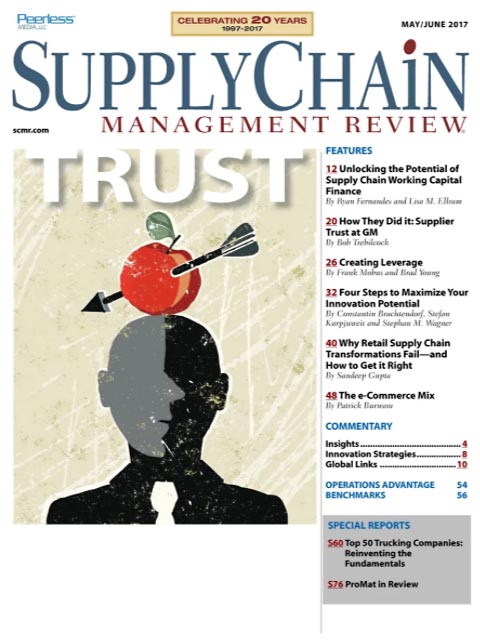Sorry, but your login has failed. Please recheck your login information and resubmit. If your subscription has expired, renew here.
May-June 2017
Trust hasn’t always been an element in supplier relationships; all too often buyers have been encouraged to carry a big stick and get tough with suppliers to get the best price—no matter the cost. That approach to procurement is beginning to change. Browse this issue archive.Need Help? Contact customer service 847-559-7581 More options
As Amazon continues its inexorable march toward distribution and order-fulfillment dominance, logistics managers are examining the opportunities all modal players are promising as they build out their e-commerce supply chains. As a consequence, the nation’s industrial transportation networks have been largely transformed.
According to the CBRE Group, the world’s largest commercial real estate services firm, there’s been a proliferation of warehouses and distribution centers (DCs) spanning 1 million square feet or larger across the nation. And while “last mile” carriers receive most of the attention these days, the traditional modal heavyweights are in charge of connecting this ever-growing web of facilities.
“The massive warehouses and DCs have sprouted from Southern California to Philadelphia, clustering around metro areas that provide the combination of road, rail, air and sea access that e-commerce users covet,” says David Egan, CBRE’s head of industrial and logistics research in the Americas.

This complete article is available to subscribers only.
Log in now for full access or start your PLUS+ subscription for instant access.
SC
MR
Sorry, but your login has failed. Please recheck your login information and resubmit. If your subscription has expired, renew here.
May-June 2017
Trust hasn’t always been an element in supplier relationships; all too often buyers have been encouraged to carry a big stick and get tough with suppliers to get the best price—no matter the cost. That approach to… Browse this issue archive. Access your online digital edition. Download a PDF file of the May-June 2017 issue.As Amazon continues its inexorable march toward distribution and order-fulfillment dominance, logistics managers are examining the opportunities all modal players are promising as they build out their e-commerce supply chains. As a consequence, the nation's industrial transportation networks have been largely transformed.
According to the CBRE Group, the world's largest commercial real estate services firm, there's been a proliferation of warehouses and distribution centers (DCs) spanning 1 million square feet or larger across the nation. And while “last mile” carriers receive most of the attention these days, the traditional modal heavyweights are in charge of connecting this ever-growing web of facilities.
“The massive warehouses and DCs have sprouted from Southern California to Philadelphia, clustering around metro areas that provide the combination of road, rail, air and sea access that e-commerce users covet,” says David Egan, CBRE's head of industrial and logistics research in the Americas.
SC
MR


Latest Supply Chain News
- How S&OP provides the answer to in-demand products
- AI, virtual reality is bringing experiential learning into the modern age
- Humanoid robots’ place in an intralogistics smart robot strategy
- Tips for CIOs to overcome technology talent acquisition troubles
- There is still work to do to achieve supply chain stability
- More News
Latest Podcast

 Explore
Explore
Topics
Latest Supply Chain News
- How S&OP provides the answer to in-demand products
- AI, virtual reality is bringing experiential learning into the modern age
- Humanoid robots’ place in an intralogistics smart robot strategy
- Tips for CIOs to overcome technology talent acquisition troubles
- There is still work to do to achieve supply chain stability
- Blooming success: The vital role of S&OE in nurturing global supply chains
- More latest news
Latest Resources

Subscribe

Supply Chain Management Review delivers the best industry content.

Editors’ Picks






